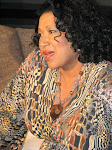 BEAUTICIAN, NOT MAGICIAN
BEAUTICIAN, NOT MAGICIANChris Rock’s new film “Good Hair” outraged some African-American women who wanted their “hair business” kept private. His intention was to share the incredible amount of time and money needed to attain “good hair.” But he hit a nerve, exposing what women would like to keep secret. Admittedly, the process is not attractive; wet hair, globs of chemicals, head full of rollers etc. The idea that naturally beauty is better than beauty created in the salon taunts some women. If you’re spending hours there it must mean you need a lot of work, therefore not “ready-made.” I disagree; created beauty is an enhancement of the raw materials and the stuff growing out of your scalp needs to be managed. The bottom line?
No one wants to be seen until the job is done.
“Good Hair” documented the techniques behind the job, and the technician in me found it helpful and fascinating. The revealing of beauty secrets should be a constant dialog between hairstylists and clients. The antiquated model of service where clients serve up their vanities to the beautician’s magic wand is not beneficial to either party. Collaboration leaves less room for error and illusion. Clients who understand the fundamentals can properly ask for techniques available to them and are generally happier with the outcome. I educate my clients, sometimes against their will, and encourage them to participate. It’s not magic; it is chemistry, technique, and artistic capacities. Talk to your stylist, ask questions, get involved.
 COLOR MY WORLD – SECRETS REVEALED
COLOR MY WORLD – SECRETS REVEALEDLet’s begin with hair lightening. Any time you are removing color the cuticle has to be opened by the chemical, peroxide. The effects of this process will permanently alter the surface of the cuticle, and color will fade more readily than natural color. There are four strengths of peroxide, 10, 20, 30 and 40 volume. They are chosen for specific needs such as covering grey, deepening color, adding highlights, etc. Peroxide is mixed with haircolor or bleach. The difference between them is that bleach lightens until the process is halted by washing. Haircolor lifts until the potency of the peroxide wears out, and then deposits the chosen color. When haircolor is first mixed with peroxide it has the greatest capacity to lighten and must be applied in a timely fashion. Haircolor is applied to the new growth to avoid overlap from previous applications. A really important detail for clients to understand is that haircolor will not lighten haircolor, only bleach will do that.
Less color equals less strength. Color molecules, a form of protein, make up the middle of the hair shaft. If you take it away you remove the guts, so to speak. Protein conditioners will help correct the cuticle and the loss of color, and a low ph shampoo will not further re-open the cuticle when washing. A client may relate the poor condition of her hair to the color service, not the high ph shampoo she’s using every day. Make sure the home maintenance practices are in place. No one needs to walk around with straw hair because there are many restorative products.
If a client with lightened hair wants to return to her natural color brown, the hair has to be filled with the colors, yellow, orange, red, and green to make brown. The quantity of each is determined by the practitioner, but it is not an exact science. If you’ve ever painted a room, you know that the color you pick may look horrible once it hits the wall; an excellent reason to leave hair coloring to trained professionals.
 SNIPPITY DO DAH
SNIPPITY DO DAHThere are three basic haircuts: Solid form, layered form, and the wedge. All haircuts are one or more of these combined. Texturizing can be done with a razor or by sliding the tip of the scissors through the hair. Both types can radically change the look of a haircut and give more or less volume depending on where the texturizing is applied. Proportion and balance determines what hair cut will look best. If a client has a short neck, large nose, weak jaw line, or thin hair, the cut should honor those details. If a client brings a picture, the concept should be tailored to fit her proportions. Clients will tell you what they like and what they want to hide.
Keep in mind, a haircut doesn’t style itself. Discontent usually rears its ugly head the next morning. Clients should not pine to reproduce their hairstyle exactly like the hairdresser does, this can cause unnecessary grief. The basics of applying styling products, blow-dryer skills, and using brushes to achieve different looks, are the most important secrets to share with them. My rule of thumb is, always apply styling products like gel and mousse at the scalp moving outward, with the exception of pomade and conditioners. It’s better to apply them to the ends and move inward. Heat from the blow-dryer should be directed toward the scalp first, stretching and pulling hair away to smooth out cowlicks. This technique fluffs the cuticle near the scalp for maximum volume. A flat brush with wide teeth is a good starter tool for moving large quantities of hair while drying. Flipping the head upside down is helpful too. Round brushes make wavy or curly ends, and are best used to finish and define hair. Apply hair spray when hair is still warm because an open cuticle holds the hairstyle longer. For curly hair, air drying or attaching a diffuser to the end of your blow-dryer will help keep the cuticle relaxed. Curly hair tends to be naturally drier than straight hair, needing crème based products or leave in conditioners for protection.
 ARMED, BUT NOT DANGEROUS
ARMED, BUT NOT DANGEROUSLess confusion, more information, and better communication is the formula for success. From this overview you might glean that hair artistry is a complicated task with many variables and possible outcomes. My wish is to eliminate the mysteries that lead to disaster and disappointment, arming clients with the necessary information to actualize...
GOOD HAIR.




















One of your BEST pieces yet! SO informative!
ReplyDeleteExcellent! Anatomy and Physiology of the Hair.
ReplyDeleteA true professional stylist.